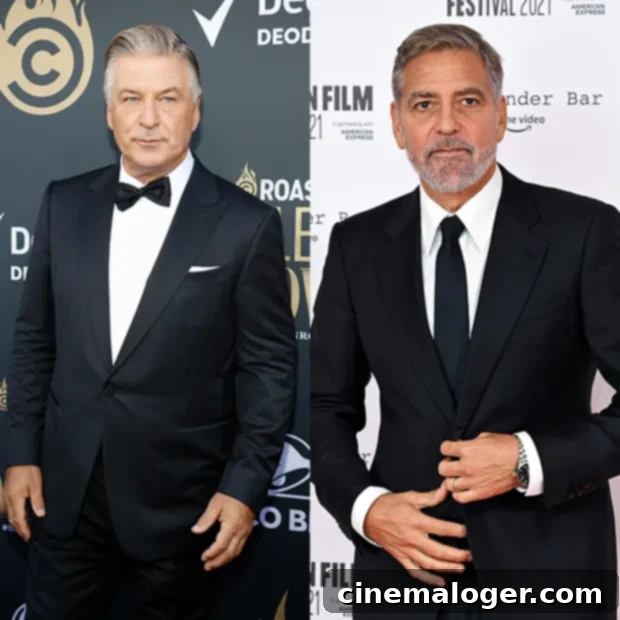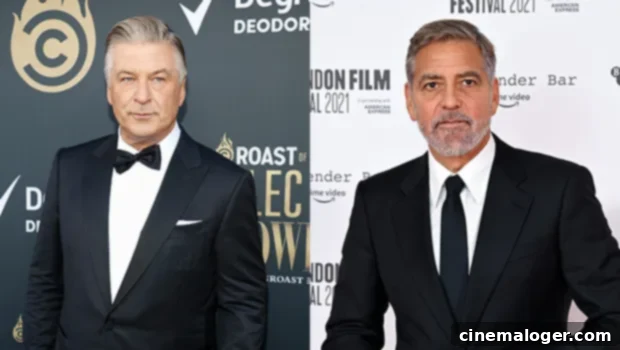Alec Baldwin Addresses George Clooney’s “Insane” Rust Shooting Comments Amidst Industry Scrutiny
In a candid and highly anticipated interview with ABC News’ George Stephanopoulos, Alec Baldwin, 63, broke his silence on the tragic “Rust” shooting incident, offering his detailed account of the events that led to the death of cinematographer Halyna Hutchins and the injury of director Joel Souza. During the revealing discussion, Baldwin also directly confronted the criticism he had received from fellow Hollywood A-lister, George Clooney, whose public remarks had labeled the incident as “insane” and “infuriating.”
The “Rust” tragedy, which occurred on October 21, 2021, on the New Mexico set of the Western film, sent shockwaves through the entertainment industry and ignited a fervent debate about firearm safety protocols on movie sets. Baldwin, who was both a star and producer on the film, discharged a prop gun that contained a live round, an outcome he vehemently insists was unintentional and beyond his direct control.
Baldwin’s Emotional Defense and Rebuttal to Critics
Speaking with Stephanopoulos on Thursday, December 2, Baldwin delivered an emotional and at times defensive explanation of his actions and understanding of the incident. He maintained that he did not pull the trigger of the F.lli Pietta .45 Long Colt revolver. Instead, he claimed the gun discharged after he cocked the hammer, an assertion that has since been met with skepticism and is a key point of contention in the ongoing investigation.
Responding to the influx of commentary from peers like George Clooney, Baldwin stated, “There were a lot of people who felt it necessary to contribute some comment to the situation, which really didn’t help the situation at all.” His remarks were a thinly veiled jab at those who, from his perspective, were quick to judge without full knowledge of the facts. Directly addressing Clooney’s stance on gun safety, Baldwin added, “If your protocol is you checking the gun every time, well, good for you. Good for you.” This response underscored Baldwin’s implied belief that not all actors follow the same exact rigorous personal checks, and perhaps more significantly, that the responsibility for ensuring a prop gun’s safety should lie with a designated armorer or prop master, not solely with the actor.
The veteran actor’s interview painted a picture of a man grappling with immense grief and public scrutiny, yet steadfast in his denial of personal culpability for the accidental firing of the weapon. When Stephanopoulos pressed him on whether he felt “guilt” for the incident, Baldwin’s response was stark: “No. I might have killed myself if I thought I was responsible, and I don’t say that lightly.” This powerful statement highlighted the profound psychological toll the event has taken on him, even as he distanced himself from direct blame.

George Clooney’s Critique: A Call for Stricter Protocols
George Clooney, a widely respected figure in Hollywood known for his principled stance and extensive experience, had voiced his strong opinions on the “Rust” shooting during the November 15 episode of Marc Maron’s “WTF” podcast. Clooney characterized Halyna Hutchins’ death as a direct consequence of “a lot of stupid mistakes.” His comments were particularly impactful because they stemmed from a place of deep industry knowledge and a history of advocating for on-set safety.
Detailing his own stringent personal protocol for handling firearms on set, the “Ocean’s Eleven” star explained, “Every single time I’m handed a gun on a set — every time — they hand me a gun, I look at it, I open it, I show it to the person I’m pointing it to, we show it to the crew. Everyone does that. Everybody knows that.” Clooney’s emphasis on “everyone does that” served as a pointed contrast to Baldwin’s explanation, suggesting a fundamental breakdown in widely accepted safety practices on the “Rust” set.
Clooney’s remarks underscored a critical point of disagreement within the industry: where exactly does the ultimate responsibility for prop gun safety lie? While Baldwin’s interview focused on the chain of command and the expectation that the armorer ensures safety, Clooney’s comments highlighted the widely held belief that every individual handling a firearm on set, regardless of their role, shares a personal responsibility for verifying its safety status. This isn’t just about an armorer; it’s about a culture of constant vigilance.
The Broader Industry Debate: Prop Gun Safety and Accountability
The “Rust” shooting has intensified a long-standing debate within Hollywood regarding prop gun safety and accountability. This tragic event, unfortunately, is not an isolated incident. The industry has grappled with similar accidents in the past, most notably the 1993 death of Brandon Lee on the set of “The Crow” and Jon-Erik Hexum in 1984. These incidents, much like the “Rust” tragedy, have repeatedly brought to the forefront the inherent dangers of using real firearms, even with blanks, in a dynamic and fast-paced film production environment.
The distinction between live rounds, blanks, and dummy rounds is crucial. Live rounds, as tragically demonstrated, are lethal. Blanks contain gunpowder but no projectile, creating a muzzle flash and sound but designed to be non-lethal (though they can still cause serious injury at close range). Dummy rounds are inert cartridges used for realism, visually identical to live rounds but containing no primer or propellant. The fatal error on the “Rust” set involved a live round being present where it should never have been, raising serious questions about the armorer’s procedures and overall set management.
Many in the industry, including directors, producers, and actors, are now openly calling for a complete ban on functional firearms on sets, advocating for the exclusive use of replica or airsoft guns that can be digitally enhanced in post-production. This shift, they argue, would eliminate the risk of live ammunition accidents entirely, moving towards a safer and equally effective cinematic approach.
.@GStephanopoulos: “Do you feel guilt?”
Alec Baldwin: “No. Someone is responsible for what happened and I can’t say who that is, but I know it’s not me.”
READ MORE: https://t.co/zYugqKhIVW #BaldwinABC pic.twitter.com/97F9wOYYTT
— ABC News (@ABC) December 3, 2021
The Ongoing Investigation and Legal Ramifications
The investigation into the “Rust” shooting remains active and complex, with authorities meticulously examining every detail of the incident. Alec Baldwin’s assertion that he “didn’t pull the trigger” of the gun that killed Halyna and injured Joel Souza is a crucial point of his defense, as he places the responsibility on those who loaded the weapon. “Someone put a live bullet in a gun, a bullet that wasn’t even supposed to be on the property,” he emphasized. “Someone is responsible for what happened, and I can’t say who that is, but I know it’s not me.”
He expressed confidence, stating that he thinks it’s “highly unlikely” he’ll be charged in the shooting. However, the legal landscape is fraught with uncertainty. Authorities are investigating all angles, including the actions of the armorer, Hannah Gutierrez-Reed, and the assistant director, David Halls, who reportedly handed Baldwin the weapon, declaring it “cold” (meaning safe).
Attorneys for Hannah Gutierrez-Reed, Jason Bowles and Robert Gorence, have publicly stated they are exploring the possibility of sabotage, suggesting that someone might have intentionally placed a live round in a box of dummy rounds on the set. This theory, while speculative, highlights the extreme complexity and the potential for multiple layers of human error or malicious intent that investigators must untangle. The question of how a live round found its way onto a film set and into a prop gun is central to the entire inquiry, and its answer will determine the ultimate accountability.
Beyond the Interview: The Human Cost and Calls for Change
Alec Baldwin’s ABC News interview marked his first formal sit-down discussion since the incident, following brief comments to the press in Manchester, Vermont, with his wife Hilaria Baldwin on October 30. His earlier public statement came via Instagram on October 22, where he expressed his profound sorrow: “There are no words to convey my shock and sadness regarding the tragic accident that took the life of Halyna Hutchins, a wife, mother and deeply admired colleague of ours.”
The emotional toll of the tragedy extends far beyond Alec Baldwin. Halyna Hutchins’ family, friends, and colleagues continue to mourn the loss of a talented and respected cinematographer. Director Joel Souza, who was also shot and injured, is recovering from his physical wounds but undoubtedly carries deep emotional scars from the harrowing experience. The entire crew of “Rust” has been impacted, with many reportedly traumatized by witnessing the event or its immediate aftermath. The incident serves as a stark reminder of the human cost when safety protocols fail.
As the investigation continues, the film industry faces a pivotal moment. The differing perspectives offered by Alec Baldwin and George Clooney, while seemingly at odds, both underscore the urgent need for a re-evaluation of on-set safety procedures, particularly concerning firearms. Whether it leads to outright bans, stricter training, enhanced supervision, or a cultural shift towards universal vigilance, the legacy of the “Rust” tragedy will undoubtedly be a renewed and intense focus on preventing such devastating incidents from ever happening again.
